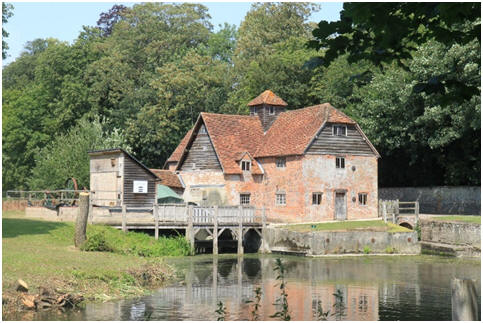On what turned out to be the hottest day of the year
members of HMG converged at Mapledurham on the
afternoon of Thursday 25 July. The mill was the
last commercially working watermill on the River
Thames: it is situated within the country estate
which has a Grade 1 listed Elizabethan house – lived
in by the same family for 500 years – and a 14th
century church with a long and fascinating history.
The miller, Corry, welcomed us and as it was so hot
we all gathered in the church where he told us many
fascinating tales of the history of the family and
the estate and church. The estate has several
different enterprises including providing a huge
campsite for Reading Festival revellers; also the
slurry produced by their herd of 800-1000 cows is
mixed with chopped maize (grown on the estate) to
fuel a biomass heating system.
The family who own the estate are Catholic and the
church has a division inside marking off one part of
it as Catholic with the rest of the church being
Church of England! Having very much enjoyed the
miller’s most entertaining stories from the past we
all walked down to the riverside and the mill.
Records show that there has been a mill on this site
for 1000 years. The central section is 13th
century; in the mid-18th century a wharf was
constructed to supply refined (white) flour to
London by barge. Now the mill has one waterwheel
and regularly produces flour – except when the
Thames floods and the water enters the mill. In
2011 an Archimedes screw was installed on the side
of the mill, originally to produce electricity for
the main house, but now in fact all the electricity
is sold directly into the national grid. Another
unusual side line is that the mill has been used as
the setting for several films, including the famous
The Eagle has Landed; all these films produce
royalties whenever they are shown!
This was a particularly delightful visit. The
miller was a most enthusiastic and interesting
guide, and at the end of the afternoon we walked
along to a nearby barn where a delicious cream tea
was laid out for us by the miller’s wife Jane.

Alan Cullen
